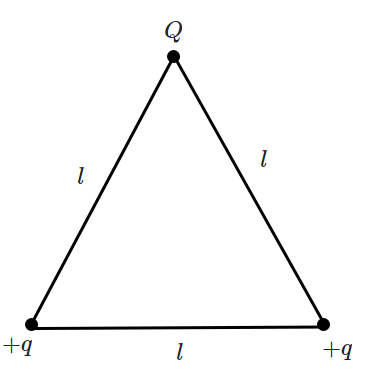Three uncharged capacitors of capacities \(C_1, C_2~\text{and}~C_3~~\) are connected to one another as shown in the figure.

If points \(\mathrm{A}\), \(\mathrm{B}\), and \(\mathrm{D}\), are at potential \(V_1, V_2 ~\text{and}~V_3\) then the potential at \(\mathrm{O}\) will be:
1. \(\frac{V_1C_1+V_2C_2+V_3C_3}{C_1+C_2+C_3}\)
2. \(\frac{V_1+V_2+V_3}{C_1+C_2+C_3}\)
3. \(\frac{V_1(V_2+V_3)}{C_1(C_2+C_3)}\)
4. \(\frac{V_1V_2V_3}{C_1C_2C_3}\)

1. \(\frac{V_1C_1+V_2C_2+V_3C_3}{C_1+C_2+C_3}\)
2. \(\frac{V_1+V_2+V_3}{C_1+C_2+C_3}\)
3. \(\frac{V_1(V_2+V_3)}{C_1(C_2+C_3)}\)
4. \(\frac{V_1V_2V_3}{C_1C_2C_3}\)
Four electric charges \(+\mathrm q,\) \(+\mathrm q,\) \(-\mathrm q\) and \(-\mathrm q\) are placed at the corners of a square of side \(2\mathrm{L}\) (see figure). The electric potential at point A, mid-way between the two charges \(+\mathrm q\) and \(+\mathrm q\) is:
1.
2.
3. zero
4.
The electric potential at a point in free space due to a charge \(Q\) coulomb is \(Q\times10^{11}~\text{V}\). The electric field at that point is:
1. \(4\pi \varepsilon_0 Q\times 10^{22}~\text{V/m}\)
2. \(12\pi \varepsilon_0 Q\times 10^{20}~\text{V/m}\)
3. \(4\pi \varepsilon_0 Q\times 10^{20}~\text{V/m}\)
4. \(12\pi \varepsilon_0 Q\times 10^{22}~\text{V/m}\)
An electric dipole of moment \(\vec {p} \) is lying along a uniform electric field \(\vec{E}\). The work done in rotating the dipole by \(90^{\circ}\) is:
1. \(\sqrt{2}pE\)
2. \(\frac{pE}{2}\)
3. \(2pE\)
4. \(pE\)
\(\mathrm{A}\), \(\mathrm{B}\) and \(\mathrm{C}\) are three points in a uniform electric field. The electric potential is:
| 1. | maximum at \(\mathrm{A}\) |
| 2. | maximum at \(\mathrm{B}\) |
| 3. | maximum at \(\mathrm{C}\) |
| 4. | same at all the three points \(\mathrm{A},\mathrm{B} ~\text{and}~\mathrm{C}\) |
Three capacitors of capacitances 3 μF, 9 μF and 18 μF are connected once in series and another time in parallel. The ratio of equivalent capacitance in the two cases will be:
1. 1 : 15
2. 15 : 1
3. 1 : 1
4. 1 : 3
Two charges q1 and q2 are placed 30 cm apart, as shown in the figure. A third charge q3 is moved along the arc of a circle of radius 40 cm from C to D. The change in the potential energy of the system is , where k is:

| 1. | 8q2 | 2. | 8q1 |
| 3 | 6q2 | 4. | 6q1 |
Three charges \(Q\), \(+q \) and \(+q \) are placed at the vertices of an equilateral triangle of side \(l\) as shown in the figure. If the net electrostatic energy of the system is zero, then \(Q\) is equal to:
| 1. | \(-\frac{q}{2} \) | 2. | \(-q\) |
| 3. | \(+q\) | 4. | \(\text{zero}\) |
A cube of a metal is given a positive charge Q. For the above system, which of the following statements is true?
| 1. | Electric potential at the surface of the cube is zero. |
| 2. | Electric potential within the cube is zero. |
| 3. | Electric field is normal to the surface of the cube. |
| 4. | Electric field varies within the cube. |
Ten electrons are equally spaced and fixed around a circle of radius R. Relative to V = 0 at infinity, the electrostatic potential V and the electric field E at the centre C are:
| 1. | \(V \neq 0 \text { and } \vec{E} \neq 0\) |
| 2. | \(V \neq 0 \text { and } \vec{E}=0\) |
| 3. | \(V=0 \text { and } \vec{E}=0\) |
| 4. | \(V=0 \text { and } \vec{E} \neq 0\) |





